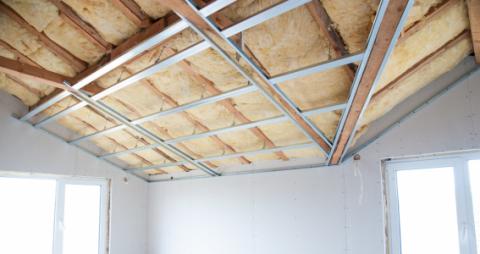
What is a Popcorn Ceiling? (and what should I do if my new house has one?)
“Popcorn” ceilings are acoustic ceiling textures that were popular in the 1960s, 1970s and into the 1980s. They were used to dampen noise and were applied through painting, or spraying, the texture onto a ceiling’s surface.
Popcorn ceilings (also called cottage cheese ceilings or stucco ceilings) hid imperfections and didn’t require painting. However, these textures may also be hiding health hazards. The earliest formulations were created with asbestos fibers, and some formulations included lead. Later versions used paper or Styrofoam to achieve the texture.
The Clean Air Act of 1978 banned the manufacture of asbestos for ceiling treatments. The ban did not, however, include on-hand inventories of the product, which means it was still applied well into the 1980s.
What Do I Need to Do?
If the house you love has a popcorn ceiling, you have five options:
- Leave it
- Scrape it
- Replace the ceiling
- Cover it with another texture
- Seal it up with another ceiling
What are the implications of each option?
Leaving the Popcorn Ceiling
If your popcorn ceilings are in good shape, and they are not a health hazard, you can leave the retro look as is. You can even freshen them up with a coat or two of paint (but realize this will make it harder to remove them later, should you decide to do so). Contact your local health department for information on testing for asbestos and lead in your home, to help make your decision.
Scraping Off a Popcorn Ceiling
This is a tough job and isn’t one that should be undertaken lightly—or without testing for lead and asbestos, since scraping will make these hazards airborne.
If your ceiling is hazard-free, you can give scraping a shot. You should try the dry-scraping method first. If it’s possible to dry-scrape it, the resulting mess will be reduced. If, however, the dry-scrape method isn’t working, and if the structure of your ceiling is good enough to handle the extra weight of moisture, you can try wetting the ceiling and then scraping.
If the ceiling has been painted, this will be a seriously challenging job. Paint will make a dry scrape more difficult, since the paint will have soaked into the “popcorn” and will serve as a glue, making it even harder to remove. Paint may also prevent water from reaching the popcorn ceiling to assist with the wet-scrape technique.
Replace the Ceiling
If the scraping technique doesn’t work, you can cut out the old ceiling, removing everything down to the studs, and install a new ceiling. Before deciding on this approach, you will need to test for asbestos and/or lead, to be safe.
Resurface the Ceiling
If you want to keep the look and feel of your home’s era, but you just don’t like the look of popcorn ceilings, you may want to cover it with another texture style that was popular at the time your house was built.
If your ceiling is in good shape and there are no areas of loose popcorn treatment, you can hire a contractor to add another layer of texture on top of the popcorn (or try this yourself if you are handy, or feeling brave). With this approach, it’s still a good idea to have the ceiling tested for asbestos and lead.
Seal It In/Cover It Up
If your ceiling does contain asbestos and/or lead, and you don’t want to remove it and pay for remediation, adding a second layer of wallboard to safely seal in the offending ceiling is an option that will allow you to paint the ceiling in that room.
If your ceiling is hazard-free, you may want to cover it for decorative reasons. In this case, you might consider a tongue-and-groove or bead board wooden ceiling, tin/metal ceiling tiles, or another creative covering (faux tray ceiling, fabric treatment, etc.).
